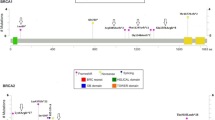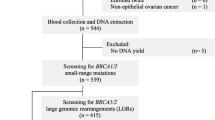Abstract
In order to adequately evaluate the clinical relevance of genetic testing in sporadic breast and ovarian cancer patients, we offered comprehensive BRCA1/2 mutation analysis in patients without a family history for the disease. We evaluated the complete coding and splice site regions of BRCA1/2 in 193 sporadic patients. In addition, a de novo mutation was further investigated with ultra deep sequencing and microsatellite marker analysis. In 17 patients (8.8%), a deleterious germline BRCA1/2 mutation was identified. The highest mutation detection ratio (3/7 = 42.9%) was obtained in sporadic patients diagnosed with breast and ovarian cancer after the age of 40. In 21 bilateral breast cancer patients, two mutations were identified (9.5%). Furthermore, 140 sporadic patients with unilateral breast cancer were investigated. Mutations were only identified in patients diagnosed with breast cancer before the age of 40 (12/128 = 9.4% vs. 0/12 with Dx > 40). No mutations were detected in 17 sporadic male breast cancer and 6 ovarian cancer patients. BRCA1 c.3494_3495delTT was identified in a patient diagnosed with breast and ovarian cancer at the age of 52 and 53, respectively, and was proven to have occurred de novo at the paternal allele. Our study shows that the mutation detection probability in specific patient subsets can be significant, therefore mutation analysis should be considered in sporadic patients. As a consequence, a family history for the disease and an early age of onset should not be used as the only criteria for mutation analysis of BRCA1/2. The relatively high mutation detection ratio suggests that the prevalence of BRCA1/2 may be underestimated, especially in sporadic patients who developed breast and ovarian cancer. In addition, although rare, the possibility of a de novo occurrence in a sporadic patient should be considered.



Similar content being viewed by others
References
Miki Y et al (1994) A strong candidate for the breast and ovarian cancer susceptibility gene BRCA1. Science 266(5182):66–71
Wooster R et al (1995) Identification of the breast cancer susceptibility gene BRCA2. Nature 378(6559):789–792
Wooster R et al (1994) Localization of a breast cancer susceptibility gene, BRCA2, to chromosome 13q12–13. Science 265(5181):2088–2090
Kauff ND et al (2002) Incidence of non-founder BRCA1 and BRCA2 mutations in high risk Ashkenazi breast and ovarian cancer families. J Med Genet 39(8):611–614
Gayther SA et al (1997) Variation of risks of breast and ovarian cancer associated with different germline mutations of the BRCA2 gene. Nat Genet 15(1):103–105
Tesoriero A et al (1999) De novo BRCA1 mutation in a patient with breast cancer and an inherited BRCA2 mutation. Am J Hum Genet 65(2):567–569
Edwards E et al (2009) Identification of a de novo BRCA1 mutation in a woman with early onset bilateral breast cancer. Fam Cancer 8(4):479–482
Diez O et al (2010) A novel de novo BRCA2 mutation of paternal origin identified in a Spanish woman with early onset bilateral breast cancer. Breast Cancer Res Treat 121(1):221–225
Hansen TV et al (2008) Novel de novo BRCA2 mutation in a patient with a family history of breast cancer. BMC Med Genet 9:58
Marshall M, Solomon S, Lawrence Wickerham D (2009) Case report: de novo BRCA2 gene mutation in a 35-year-old woman with breast cancer. Clin Genet 76(5):427–430
Robson M et al (2002) Unique de novo mutation of BRCA2 in a woman with early onset breast cancer. J Med Genet 39(2):126–128
van der Luijt RB et al (2001) De novo recurrent germline mutation of the BRCA2 gene in a patient with early onset breast cancer. J Med Genet 38(2):102–105
Claes K et al (1999) Mutation analysis of the BRCA1 and BRCA2 genes results in the identification of novel and recurrent mutations in 6/16 flemish families with breast and/or ovarian cancer but not in 12 sporadic patients with early-onset disease. Mutations in brief no. 224. Online. Hum Mutat 13(3):256
van der Hout AH et al (2006) A DGGE system for comprehensive mutation screening of BRCA1 and BRCA2: application in a Dutch cancer clinic setting. Hum Mutat 27(7):654–666
De Leeneer K et al (2009) Genotyping of frequent BRCA1/2 SNPs with unlabeled probes: a supplement to HRMCA mutation scanning, allowing the strong reduction of sequencing burden. J Mol Diagn JMD 11(5):415–419
De Leeneer K et al (2008) Rapid and sensitive detection of BRCA1/2 mutations in a diagnostic setting: comparison of two high-resolution melting platforms. Clin Chem 54(6):982–989
De Leeneer K et al (2011) Massive parallel amplicon sequencing of the breast cancer genes BRCA1 and BRCA2: opportunities, challenges, and limitations. Hum Mutat 32(3):335–344
Rohlin A et al (2009) Parallel sequencing used in detection of mosaic mutations: comparison with four diagnostic DNA screening techniques. Hum Mutat 30(6):1012–1020
Thomas RK et al (2006) Sensitive mutation detection in heterogeneous cancer specimens by massively parallel picoliter reactor sequencing. Nat Med 12(7):852–855
Carlson KM et al (1994) Parent-of-origin effects in multiple endocrine neoplasia type 2B. Am J Hum Genet 55(6):1076–1082
Schuffenecker I et al (1997) Prevalence and parental origin of de novo RET mutations in multiple endocrine neoplasia type 2A and familial medullary thyroid carcinoma, Le Groupe d’Etude des Tumeurs a Calcitonine. Am J Hum Genet 60(1):233–237
Glaser RL et al (2000) Paternal origin of FGFR2 mutations in sporadic cases of Crouzon syndrome and Pfeiffer syndrome. Am J Hum Genet 66(3):768–777
Lazaro C et al (1996) Sex differences in mutational rate and mutational mechanism in the NF1 gene in neurofibromatosis type 1 patients. Hum Genet 98(6):696–699
Claes K et al (1999) Mutation analysis of the BRCA1 and BRCA2 genes in the Belgian patient population and identification of a Belgian founder mutation BRCA1 IVS5 + 3A > G. Dis Markers 15(1–3):69–73
Claes K et al (2004) BRCA1 and BRCA2 germline mutation spectrum and frequencies in Belgian breast/ovarian cancer families. Br J Cancer 90(6):1244–1251
King MC, Marks JH, Mandell JB (2003) Breast and ovarian cancer risks due to inherited mutations in BRCA1 and BRCA2. Science 302(5645):643–646
Meijers-Heijboer EJ et al (2000) Presymptomatic DNA testing and prophylactic surgery in families with a BRCA1 or BRCA2 mutation. Lancet 355(9220):2015–2020
Peto J et al (1999) Prevalence of BRCA1 and BRCA2 gene mutations in patients with early-onset breast cancer. J Natl Cancer Inst 91(11):943–949
Ford M, Murdoch J (1997) The management of ovarian cancer. Br J Hosp Med 58(11):581–583
Couch FJ et al (1996) BRCA2 germline mutations in male breast cancer cases and breast cancer families. Nat Genet 13(1):123–125
Haraldsson K et al (1998) BRCA2 germ-line mutations are frequent in male breast cancer patients without a family history of the disease. Cancer Res 58(7):1367–1371
Johannesdottir G et al (1996) High prevalence of the 999del5 mutation in icelandic breast and ovarian cancer patients. Cancer Res 56(16):3663–3665
Mavraki E et al (1997) Germline BRCA2 mutations in men with breast cancer. Br J Cancer 76(11):1428–1431
Syrjakoski K et al (2004) BRCA2 mutations in 154 Finnish male breast cancer patients. Neoplasia 6(5):541–545
Charef-Hamza S et al (2005) Loss of heterozygosity at the BRCA1 locus in Tunisian women with sporadic breast cancer. Cancer Lett 224(2):185–191
Uhrhammer N et al (2008) BRCA1 mutations in Algerian breast cancer patients: high frequency in young, sporadic cases. Int J Med Sci 5(4):197–202
Ellis D et al (2000) Low prevalence of germline BRCA1 mutations in early onset breast cancer without a family history. J Med Genet 37(10):792–794
Kwon JS et al (2010) Expanding the criteria for BRCA mutation testing in breast cancer survivors. J Clin Oncol 28(27):4214–4220
Ottini L et al (2000) BRCA1 and BRCA2 mutations in central and southern Italian patients. Breast Cancer Res BCR 2(4):307–310
Borg A (2010) Characterization of BRCA1 and BRCA2 deleterious mutations and variants of unknown clinical significance in unilateral and bilateral breast cancer: the WECARE study. Hum Mut 31(3):E1200-40
Acknowledgments
This project was realized with the funding of an Emmanuel van der Schueren scholarship of the Flemish foundation against cancer to Kim De Leeneer. This research was supported by grant 1.5.150.07 from the Fund for Scientific Research Flanders (FWO) to Kathleen Claes and by GOA grant BOF10/GOA/019 (Ghent University). Bruce Poppe is a senior clinical investigator from FWO.
Conflict of interest
None.
Author information
Authors and Affiliations
Corresponding author
Rights and permissions
About this article
Cite this article
De Leeneer, K., Coene, I., Crombez, B. et al. Prevalence of BRCA1/2 mutations in sporadic breast/ovarian cancer patients and identification of a novel de novo BRCA1 mutation in a patient diagnosed with late onset breast and ovarian cancer: implications for genetic testing. Breast Cancer Res Treat 132, 87–95 (2012). https://doi.org/10.1007/s10549-011-1544-9
Received:
Accepted:
Published:
Issue Date:
DOI: https://doi.org/10.1007/s10549-011-1544-9




